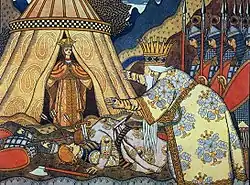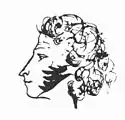The Tale of the Golden Cockerel
The Tale of the Golden Cockerel (Russian: «Сказка о золотом петушке», romanized: Skazka o zolotom petushke) is the last fairy tale in verse by Alexander Pushkin. Pushkin wrote the tale in 1834 and it was first published in literary magazine Biblioteka dlya chteniya (Library for Reading) in 1835. While not officially based on any specific fairy tale, a number of similar stories were later revealed by scholars, most famously by Anna Akhmatova in her 1933 essay Pushkin's Last Fairy Tale. Among the influences named were the Legend of the Arabian Astrologer from Tales of the Alhambra by Washington Irving, Der goldene Hahn (1785) by Friedrich Maximilian Klinger and Kaib (1792) by Ivan Krylov. In turn, all of them borrowed from the ancient Copts legend first translated by the French Arabist Pierre Vattier in 1666 using the 1584 manuscript from the collection of Cardinal Mazarin.[1][2][3]

Adaptations
- 1907 – The Golden Cockerel, opera by Nikolai Rimsky-Korsakov.
- 1967 – Golden Cockerel, USSR, production of a film studio "Soyuzmultfilm", popular animated film by Alexandra Snezhko-Blotskaya.
Literature
- Alexander Pushkin: A Critical Study by A.D.P. Briggs, Rowman & Littlefield Publishers, 1982.
References
- Anna Akhmatova (1933). Pushkin's Last Fairy Tale. — Saint Petersburg: Zvezda №1, p. 161—176
- The Golden Age of Russian Literature and Thought // ed. by Derek Offord (1992). — London: Palgrave Macmillan, p. 25—26 ISBN 978-0-333-55733-4
- Boiko K. A. (1976). About the Arab Source of the Golden Cockerel Motive in Pushkin's Fairy Tale // from the Vremennik of the Pushkin's Commission. — Leningrad: Nauka, p. 113—120 (in Russian)
External links
| Russian Wikisource has original text related to this article: |
- (in Russian) «Сказка о золотом петушке» available at Russian Virtual Library
- The Tale of the Golden Cockerel, translated by Walter W. Arndt
